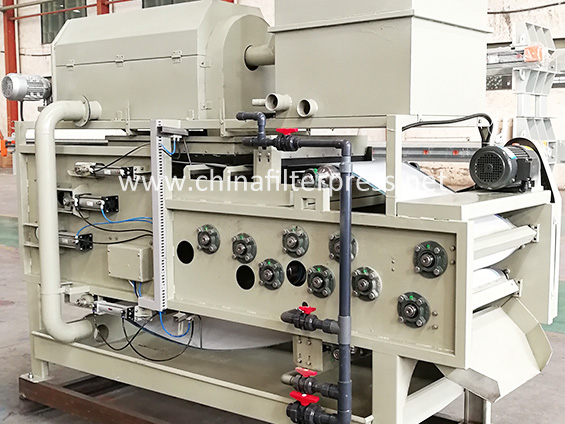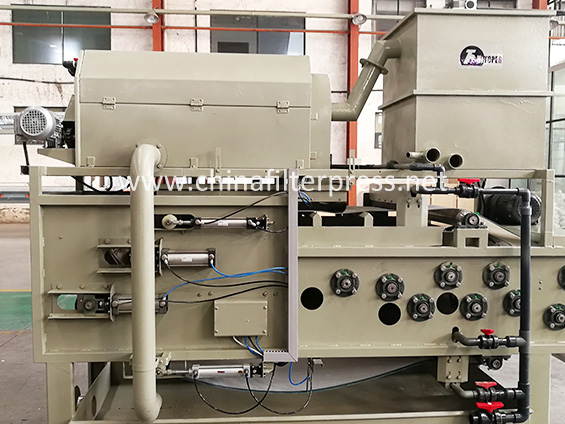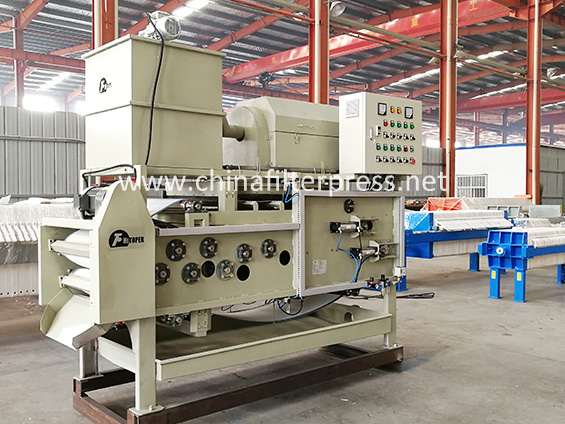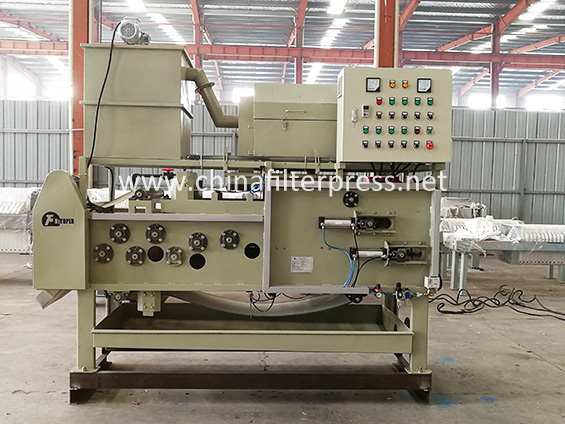







The belt filter is an industrial machine whose dehydration is a mechanical process designed to separate liquid from solid waste (especially sludge). It is mainly used for sludge dehydration in the chemical industry, mining industry and water treatment.
The belt filter is an industrial machine whose dehydration is a mechanical process designed to separate liquid from solid waste (especially sludge). It is mainly used for sludge dehydration in the chemical industry, mining industry and water treatment. The machine operates continuously, has a high degree of automation, is energy-saving, efficient, easy to use and maintain, and is an ideal equipment for sludge treatment.

Currently, the filter plate of filter press is made of polymer or polymer coated steel. According to the needs, the filter plate can also choose cast iron or stainless steel materials, which provide a good drainage surface for the filter cloth. The size range of the filter plate is 250 ×250 mm to 2.0 × 2.0 meters, and larger or smaller sizes are available.
Filter press usually uses filter cloth as filter medium, which is made of polypropylene filter cloth, non-woven fabric, cotton cloth, etc. filter paper board, cotton pulp board or filter membrane can also be used as filter medium as required. Generally, the cake thickness of plate and frame filter press can reach 50 mm, but in extreme cases, it can be increased to 200 mm. The box filter press (concave filter press) can form a filter cake with a thickness of 30-40mm.
Before using the filter press for filtration, if the solid suspension has precipitated, the mixed liquid needs to be pretreated, which can improve the performance of the filter press because it increases the porosity of the filter cake, thus speeding up the filtration speed. The size of floc can be controlled by changing temperature, concentration and pH value. In addition, if the filter cake is impermeable and not conducive to the flow of filtrate, filter aids can be added in the pretreatment process to increase the porosity of the filter cake, reduce the resistance of the filter cake and obtain a thicker filter cake. However, the filter aid needs to be able to be removed from the filter cake by physical or chemical treatment. A common filter aid is diatomite, with a porosity of 0.85.
1. It adopts advanced Austrian technology and has a beautiful appearance.
2. The structural rigidity is large, the operation is stable, and the noise is low.
3. It is equipped with advanced concentration pretreatment equipment, which has a good sludge flocculation effect and low operating cost.
4. The gravity dehydration area is equipped with an advanced distributor, which makes the material evenly distributed and extends the life of the filter belt.
5. It has an extra-long gravity dehydration area and a wedge-shaped dehydration area, and the material is fully dehydrated to ensure that the material will not overflow in the pressing area.
6. The roller system is arranged scientifically and orderly, and the gravity dehydration, wedge-shaped dehydration, and pressing dehydration are distributed and discharged, with complementary interference. The pressing dehydration roller has a large diameter ratio and a good dehydration effect, so the production capacity is large and energy-saving and efficient.
7. Continuous operation from feeding to discharging mud cake, with high degree of automation. PLC interface can be set as needed to facilitate centralized control by microcomputer.
8. The power transmission mechanism adopts mechanical or variable frequency stepless speed regulation, with a large speed regulation range and wide adaptability.
9. Equipped with reliable backwashing equipment to ensure the dehydration effect of the filter belt.
10. Pneumatic tensioning and pneumatic automatic deviation correction devices are adopted to ensure the safe and normal operation of the filter belt.
11. The operation is safe and reliable, and infrared safety protection and all-round emergency safety parking devices are adopted.
12. Filter belts of different specifications and models can be configured according to different materials, with high filtration accuracy.
Efficiency: These machines optimize the dewatering process, resulting in higher throughput.
Cost-effectiveness: Reduced sludge volume reduces transportation and disposal costs.
Adaptability: Belt filter presses can handle a wide range of sludge types, making them suitable for different applications.
Belt filter presses are also known for their high capacity throughput, low initial cost, and low energy operating costs.
The operation of a belt filter press involves several key steps:
Sludge preparation: Conditioning the sludge with polymers to enhance the separation of water from solids.
Feeding: Prepared sludge enters the press and is sandwiched between two porous belts.
Squeezing: As the belts move, they apply mechanical pressure, forcing water out through the porous surface.
Collection: The result is a drier sludge cake ready for disposal or further processing.
This method is efficient and effective, producing a high solids content in the final product while saving energy.
Sludge management faces many challenges, including odor control, regulatory compliance, and the environmental impact of waste. Belt filter presses for sludge dewatering effectively address these issues. By reducing sludge volume, companies can reduce disposal costs and strengthen their sustainability initiatives.
Belt filter presses are mainly used for dewatering sludge and mud, etc. Belt filter presses are widely used in both municipal and industrial fields, including urban sewage and wastewater treatment, metallurgy and mining, steel plants, coal plants, breweries, printing and dyeing plants, tanneries, as well as chemical plants and paper mills.
Municipal sludge includes raw sludge, anaerobic digestion sludge and aerobic digestion sludge, alum sludge, lime softening sludge and river silt. In industry, any sludge or mud comes from food processing waste, pulp and paper waste, chemical sludge, pharmaceutical waste, industrial waste treatment sludge and petrochemical waste. These wastes can include mixed sludge, ore pulp, dust sediment, selected coal washing mud, biological sludge, primary sludge and straw, wood or waste paper pulp.
Some dewatering goals include reducing volume to reduce transportation and storage costs, removing liquids before landfill disposal, reducing fuel requirements before further drying or incineration, producing sufficient compost material, avoiding runoff and accumulation when used for land application, and optimizing other drying processes. Belt filter presses are specially designed for these specific applications and feed materials.
Based on the introduced advanced technology, DNY belt filter press is developed and designed based on DY belt filter press. DNY belt filter press is one ideal sludge-dewatering equipment which is widely used in chemical, coal, paper making, food staff, urban sewage and other industries. It also can be used as a liquid-solid separating machine. It features in high efficiency, good dewatering effects and low consumption. Using this kind of DNY belt filter press, no need of concentrating pond, thus saving the investment and floor area.
1.It is a integration equipment, automatic control, continuous operation;
2.Low power consumption, long service life;
3.High concentration dehydration efficiency and high solid content of mud cake;
4.Easy to use and maintain;
5.Low noise, economic and reliable, with wide range of application.
Municipal WWTP Sludge
Pulp and Paper Sludge
Water Plant Sludge
Aggregate Fines
Septage
Meat Processing Sludge
Canning Sludge
Animal Manure
Ink Sludge
Mineral Slurries
Grease Trap Waste
Food Products
1.Slurry and potions go through the pipe to the conditioning tank.
2.The slurry after conditioning process then flow into the drum thickener, under the action of centrifugal force,the water in the slurry is screened.
3.Then the dehydrated slurry distribution to the filter belt, with the filter belt movement, the slurry on the filter belt affected gradually increased squeezing pressure,then the filter cake via number of S-type press roll crush , complete the cake dehydration.
| Model | DY750 | DY1000 | DY1500 | DY2000 | DY2500 | DY3000 | ||
| Filter width(mm) | 750 | 1000 | 1500 | 2000 | 2500 | 3000 | ||
| Capacity (m³/h) (enter concentration 1.5-2.5% ) | 6~9 | 8~12 | 12~18 | 16~24 | 20~30 | 28~38 | ||
| Dry volume (kg/h) | 110~225 | 150~300 | 225~450 | 300~600 | 375~750 | 420~950 | ||
| Moisture content (%) | 63~84.5 | 63~84.5 | 63~84.5 | 63~84.5 | 63~84.5 | 63~84.5 | ||
| Motor power (KW) | 1.5 | 1.5 | 1.5 | 2.2 | 2.2 | 2.2 | ||
| Reference Dimensions (mm) | L | 4250 | 4250 | 4250 | 4250 | 4250 | 4250 | |
| W | 1630 | 1880 | 2380 | 2920 | 3420 | 3920 | ||
| H | 2100 | 2100 | 2100 | 2100 | 2100 | 2100 | ||
| Weight (kg) | 2570 | 2920 | 3590 | 4490 | 5520 | 6220 | ||
| Type | DNY500 | DNY750 | DNY1000 | DNY1250 | DNY1500 | DNY1500L | DNY1750 | DNY2000 | DNY3000 | Remarks | ||
| Belt width (mm) | 500 | 750 | 1000 | 1250 | 1500 | 1500 | 1750 | 2000 | 3000 | |||
| Capacity (m3/h) 1.5~2.5% Concentration |
3.0~5.2 | 4.5~7.5 | 6.5~10.5 | 7.5~12.5 | 9.5~16 | 12~20.5 | 15~24.5 | 18~30 | 40~55 | Depends on the sully feature | ||
| Dry volume (kg/h) | 45~78 | 68~113 | 98~158 | 113~188 | 143~240 | 180~308 | 225~368 | 270~450 | 360~675 | Depends on the sully feature | ||
| Moisture content (%) | 63~84.5 | 63~84.5 | 63~84.5 | 63~84.5 | 63~84.5 | 63~84.5 | 63~84.5 | 63~84.5 | 63~84.5 | Depends on the sully feature | ||
| Power (KW) |
Driving motor (Variable speed) | 0.75 | 0.75 | 0.75 | 0.75 | 0.75 | 0.75 | 0.75 | 0.75 | 1.5 | ||
| Conditioning mixer | 0.37 | 0.37 | 0.37 | 0.37 | 0.37 | 0.37 | 0.37 | 0.37 | 0.55 | |||
| Drum thickener | 0.37 | 0.37 | 0.37 | 0.37 | 0.37 | 0.37 | 0.37 | 0.37 | 0.55 | |||
| Pressed filtrate plate | equipped | equipped | equipped | equipped | equipped | equipped | no | no | no | Meet requirement | ||
| Reference Dimensions (mm) |
L | 2600 | 2600 | 2600 | 2600 | 2600 | 3190 | 3190 | 3190 | 4300 | Before ordering ask for actual installation dimensions | |
| W | 1050 | 1300 | 1550 | 1800 | 2050 | 2300 | 2300 | 2550 | 3550 | |||
| H | 2175 | 2175 | 2270 | 2270 | 2270 | 2510 | 2510 | 2510 | 3010 | |||
| Size (mm) | 3800×3310 | 3800×3310 | 3800×3310 | 3800×3310 | 3800×3310 | 3800×3310 | 3800×3310 | 3800×3310 | 3800×3310 | |||
| weight (kg) | 830 | 1000 | 1210 | 1450 | 1850 | 2200 | 2450 | 2850 | 3600 | |||